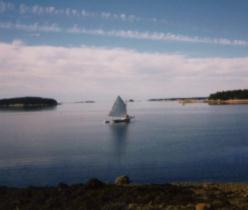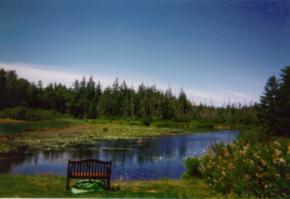Weather Course


I looked back now at Staten Island with the Horn behind, and
I hoped to God I should come that way no more in sail. I had
hoped that before, perhaps even more fervently on at least two
occasions; yet here I was again. And I made no promises and took
no oaths, for I knew well that my life, such as it is, is too
bound up in these ships for me to make forecasts. If the ships
bring me here again I suppose I shall come. But I hope not.
-- Alan Villiers
 Unlike Cape Horn, in July of 1997, I found myself once again at
WoodenBoat School in Maine. I had been there once before for a course,
Cruising on Christmas, but
what captured my eye this year was a course on weather. The momement
you take up sailing is the momement you become connected into this
complex system called weather, and I decided I should know a bit more
about it. The course was taught by Michael Carr, the president of
Ocean Strategies a
routing company (among other things). Bottom Line: I had a great time.
The course was exceedingly interesting and useful.
The weather was great (unlike the foggy experience of last time)
leaving evening time for sailing on WoodenBoat's little wooden boats,
and hanging out with folks who are interested in sailing. Plus we had
tropical storm "Danny" to track.
Unlike Cape Horn, in July of 1997, I found myself once again at
WoodenBoat School in Maine. I had been there once before for a course,
Cruising on Christmas, but
what captured my eye this year was a course on weather. The momement
you take up sailing is the momement you become connected into this
complex system called weather, and I decided I should know a bit more
about it. The course was taught by Michael Carr, the president of
Ocean Strategies a
routing company (among other things). Bottom Line: I had a great time.
The course was exceedingly interesting and useful.
The weather was great (unlike the foggy experience of last time)
leaving evening time for sailing on WoodenBoat's little wooden boats,
and hanging out with folks who are interested in sailing. Plus we had
tropical storm "Danny" to track.
 Basically the class started out each morning with us meeting at the
boathouse, which overlooks the water and walking over to print out the
latest weather charts from off the internet. My
weather page lists most of the sources of information we used. We
then came back and spent some time analyzing this information, plus
integrating it with what we saw out the window, and the data from a
little weather station Michael brought along. We also had access to
WoodenBoat's weather fax, which allowed us to pick up weather information
from Halifax to get the Canadian perspective. [You can obviously tune
the weather fax to U.S. stations, but we had some reception problems].
Basically the class started out each morning with us meeting at the
boathouse, which overlooks the water and walking over to print out the
latest weather charts from off the internet. My
weather page lists most of the sources of information we used. We
then came back and spent some time analyzing this information, plus
integrating it with what we saw out the window, and the data from a
little weather station Michael brought along. We also had access to
WoodenBoat's weather fax, which allowed us to pick up weather information
from Halifax to get the Canadian perspective. [You can obviously tune
the weather fax to U.S. stations, but we had some reception problems].
 After that we had lectures, which were a mix of theory and practice,
spiced with Sea Tales, exercises, slides, and overheads. We'd break
for lunch which was brought down from the kitchen, then either get our
next fix of weather maps or go back for more lecture. After class students
have access to a set of wooden sailing and rowing craft, though some of
the evenings the wind was pretty light.
After that we had lectures, which were a mix of theory and practice,
spiced with Sea Tales, exercises, slides, and overheads. We'd break
for lunch which was brought down from the kitchen, then either get our
next fix of weather maps or go back for more lecture. After class students
have access to a set of wooden sailing and rowing craft, though some of
the evenings the wind was pretty light.
 I've included a partial bibliography from the class for those who might
be interested. There was a huge notebook that was handed out, which is
not included here, and rumor has it that Michael will be producing a
weather book himself. Obviously different folks learn in different ways,
but I find that having a lecturer and being able to ask questions is a
lot more effective for me than pulling material from a book. I'll probably
get some of these books, and work my way through the notebook, but the
class is what made it gel for me.
I've included a partial bibliography from the class for those who might
be interested. There was a huge notebook that was handed out, which is
not included here, and rumor has it that Michael will be producing a
weather book himself. Obviously different folks learn in different ways,
but I find that having a lecturer and being able to ask questions is a
lot more effective for me than pulling material from a book. I'll probably
get some of these books, and work my way through the notebook, but the
class is what made it gel for me.
Meteorology for Seafarers by Frampton
Where the Wind Blows from Breakwater Books
The Concise Guide to Carribbean Weather by David Jones
